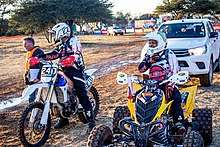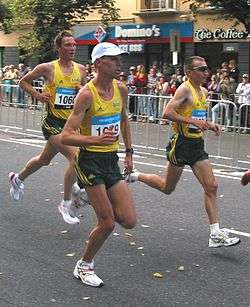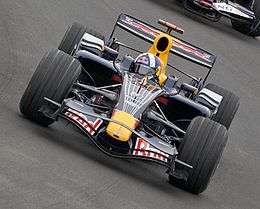Rally raid
Rally raid, also known as cross-country rallying, is a form of long distance off-road racing that takes place over several days. The length of the event can be as short as 2–3 days for a cross-country baja to as long as 15 days with marathon rallies like the Dakar Rally; with other cross-country rally events lasting 4–5 days. With skill in navigation being key, the driving skill and endurance of riders, drivers, co-drivers, and machines are put to the test. The total distance covered can be anywhere between 600km to over 5000km with terrain ranging from sandy dunes, forest roads, mountain roads, and dry river beds; among others.[1][2][3]


The most well known rally raid is the Dakar Rally; a marathon rally which can last anywhere from 10–15 days. Other prominent marathon rallies include the Africa Eco Race and Silk Way Rally. Well known examples of cross-country rallies include the Abu Dhabi Desert Challenge and Rallye du Maroc. The Baja Aragón is an example of a cross-country baja with the Baja Russia Northern Forest taking place entirely in snow. Other examples of rally raid races include the TransAnatolia Rally Raid, Hellas Rally Raid, Borneo Rally Raid, and Raid De Himalaya.
The first African rally raid run was the Côte-Côte Rally, first held in December 1976.[4]
While the sport is most known for the Dakar Rally, a number of international and national series are also run. Internationally the FIA World Cup for Cross-Country Rallies and FIA World Cup for Cross-Country Bajas is held for cars, buggies, SSVs, & trucks while the FIM Cross-Country Rallies World Championship and FIM Bajas World Cup exists for motorbikes & quads. National cross-country rally championships are held in Poland, Portugal, Russia, Spain, and South Africa, among others. For amateurs the Budapest-Bamako has been considered the world's largest amateur rally raid spanning two continents and 9000 kilometers.[5]
Navigation
Navigation is primarily accomplished using a paper roadbook in conjunction with a digital odometer to measure distance. The use of GPS or GPS-enabled devices, in contrast with desert racing, is not allowed. Competitors have no knowledge of the course until they receive the roadbook and any sort of pre-running is prohibited; which highlights the adventure aspect of rally raid. This is in stark contrast to rallying and desert racing where pre-running or reconnaissance is required or recommended for optimal performance on the course. The roadbook that is used is not as precise as the pacenotes used in stage rally making navigation just as important as the driving. Bike and quad riders also have to navigate on their own while riding their vehicle; making concentration key during a rally raid event.[6][7]
Vehicles and classes
The three major competitive groups in rally raid are the motorcycle (moto) class, including quads; the car class, ranging from 4x4 desert-racing prototypes to buggies and SxS vehicles; and the T4 & T5 truck class. Some events likes the ASO-sanctioned Dakar Rally separate the quads and SxSs into their own classes while the FIA and FIM-sanctioned events keep them as sub-classes.
Moto class
The Moto class is divided between three groups. Group 1 is Marathon bikes, which are mildly modified production motorcycles, subdivided between engines of greater and less than 451 cc (28 cu in). Group 2 is Super-Production bikes, which are more substantially modified than Marathon bikes, subdivided between engines of greater and less than 451 cc. Group 3 is reserved for quads, and is subdivided between engines of greater and less than 500 cc.
Popular motorcycles include those made by KTM, Yamaha, Honda, Kawasaki, and Husqvarna because many of their bikes have finished in top positions. BMW motorcycles and Triumph have also been successful in the Dakar.
Car class—T1, T2, T3 and Open

The car class is made up of vehicles weighing less than 3,500 kg (7,716 lb) and subdivided into several categories. The T1 Group is made up of Improved Cross Country Vehicles, such as the Mitsubishi MRX09 Racing Lancer, Toyota Hilux overdrive[8], Mini X-raid buggy[9], and the T2 Group is made up of Cross Country Series Production vehicles such as Toyota Land Cruiser, Nissan Patrol and Mercedes-Benz GLE-Class. The Open class accepts weight-qualifying vehicles, such as SCORE International trucks, while the T3 category refers to Side by Side (UTV) vehicles made by Polaris, Yamaha, and Can-Am.
Originally, European utility vehicles like the Renault 4, Land Rover, Range Rover, Mercedes-Benz G, Volkswagen Iltis and the Pinzgauer, as well the Japanese Toyota Land Cruiser, dominated the sport.
Other prominent examples in the Car Class included the Mitsubishi Pajero/Montero, the Volkswagen Race Touareg, the Bowler Wildcat 200 and the Nissan Navara. Recent race winners include the Peugeot 3008 DKR and the Mini All4 Racing.
Truck class—T4 and T5

The Truck class, also known as "Camions" or "Lorries" is made up of vehicles weighing more than 3,500 kg (7,716 lb). They are divided into two groups, Group T4 and T5.
The T4 Group is made up of trucks that actually participate in the competition, while the T5 Group is reserved for rally support trucks, which means they travel from bivouac to bivouac to support other competition vehicles. The T4 Group is further divided into two subgroups: the T4.1 class for production trucks, and the T4.2 class for modified trucks. T4 trucks may provide assistance during the special stages, but must be homologated vehicles. T5 trucks do not have to be homologated.
The T4 Group has been composed of vehicles manufactured by Tatra, LIAZ, Volkswagen, Kamaz, Hino, UD Trucks, MAN, DAF, MAZ, ZiL, Mercedes-Benz Unimog, Renault Kerax, Scania, Iveco and GINAF. In the 1980s, a strong rivalry between DAF and Mercedes-Benz led to vehicles which had twin engines and more than 1000 hp (750 kW). Later, Tatra and Kamaz took the race up. After 2000, renewed competition started in the truck class between DAF, Tatra, Mercedes-Benz, Iveco and Kamaz.
Notable events
- FIA World Cup for Cross-Country Rallies
- FIM Cross-Country Rallies World Championship
- Dakar Rally
- Africa Eco Race
- Silk Way Rally
- Abu Dhabi Desert Challenge
- Rallye OiLibya du Maroc
- Merzouga Rally
- Rallye des Pharaons
- Central Europe Rally (2008)
- Budapest-Bamako – Largest amateur rally raid
- Baja Aragón
- Northern Forest
- Sonora Rally
- Rally Adventure Georgia
- Rimba Raid
References
- "FIA Cross-Country Rallies General Prescriptions – 2019" (PDF). fia.com. 10 December 2018. Retrieved 15 March 2019.
- "2019 FIM Cross-Country Rallies World Championship Regulations" (PDF). fim-live.com. 13 February 2019. Retrieved 15 March 2019.
- "2019 FIM Bajas World Cup Regulations" (PDF). fim-live.com. 12 February 2019. Retrieved 15 March 2019.
- The Motorsport Memorial Team, info@motorsportmemorial.org. "Motorsport Memorial". Motorsport Memorial. Retrieved 2017-08-20.
- Race Dezert http://www.race-dezert.com/home/the-trans-saharan-budapest-bamako-rally-49536.html
- "Top Five Differences Between Desert Racing And Rally Raid - race-deZert.com". race-dezert.com. 15 January 2016. Retrieved 19 April 2018.
- "FAQ". sonorarally.com. Retrieved 19 April 2018.
- Overdrive Toyota racing. "Home page".
- Mini X-raid team. "Home page".
| Wikimedia Commons has media related to Rally raid racing. |

